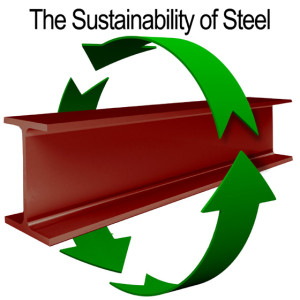Steel Buildings Help Preserve Our Resources for Future Generations
To meet the criteria for green building, a product needs to be “sustainable.” But what does sustainable mean?
 Sustainable building materials minimize environmental impacts while maximizing efficient use. Sustainability meets present needs without sacrificing future needs.
Sustainable building materials minimize environmental impacts while maximizing efficient use. Sustainability meets present needs without sacrificing future needs.
Most natural resources are finite. If we squander those resources today, we compromise the lives and options of future generations.
Sustainable Characteristics of Steel
Steel’s two main ingredients are iron and recycled steel.
Iron is one of the Earth’s most plentiful elements. However, the real secret of steel’s sustainability is its amazing recycling abilities:
- Steel is 100% recyclable.
- Modern steel processing allows for an extremely high recycled content.
- Steel loses none of its qualities or strength— no matter how many times it is recycled.
- There is potentially no limit to how many times steel can be recycled.
- Once steel is produced, it becomes a permanent resource for new steel.
- About 98% of all steel is collected for recycling.
- Creating new steel from recycled steel drastically cuts energy usage.
- Magnetic separation makes steel simple and economical to recycle.
A product must have at least 25% recycled content to be considered a “green” material. All structural steel today contains a high recycled content. RHINO steel building framing contains as much as 90.7% recycled content.
The LEED system (Leadership in Energy & Environmental Design) awards structural steel its maximum numerical rating.
Steel: Minimizing Environmental Impacts
The steel industry has made amazing strides in minimizing the environmental impacts of steel production.
- Today’s steel is 40% stronger than steel produced just 25 years ago.
- Producing steel today uses 67% less energy than it did 35 years ago.
- Greenhouse emissions for steel production are 45% less than 40 years ago.
- Today, 95% of all water used in steel production is recycled. Now steel production consumes only 70 gallons of water per ton of steel.
- In 1992, the Kyoto Protocol committed United Nations member countries to specific goals on reducing carbon dioxide emissions. The steel industry has exceeded those goals by 240%!
- The Environmental Protection Agency (EPA) gives steel a “best industry performance” designation.
Steel lasts far longer than other building materials, extending the lifespan of a structure and further reducing the environmental impact.
Pre-engineered Steel Buildings: Maximizing Efficiency
Pre-engineered systems take maximum advantage of the strength of steel. Modern computer design and engineering software allows steel building producers to create the strongest, most durable structure possible— with the minimum amount of steel.
Everything in a pre-engineered metal building package is cut, formed, welded, drilled, and marked at the factory. Framing is assembled at the job site, like an adult-sized erector set. Waste is kept to a minimum. Whatever steel remains is sold to a metal recycler.
Build Green with Sustainable Steel Buildings
Be a part of the solution— not part of the pollution. Build stronger, safer, and smarter with prefabricated steel buildings from RHINO using sustainable building materials.
Call RHINO at 940.383.9566 now for a free quote on your next residential, commercial, or industrial building project.
